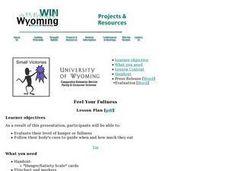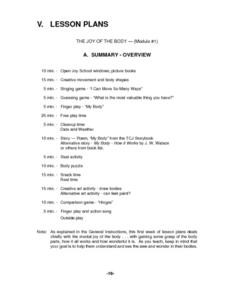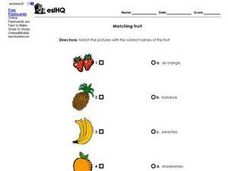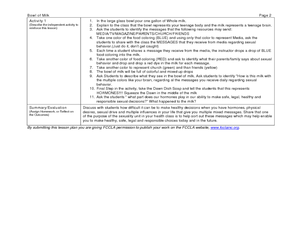Curated OER
Ecstasy
Learners view a PSB "In the Mix" video about the effects and abuse of the drug Esctasy. They participate in a class discussion, identify the body's reaction to Ecstasy, investigate the laws surrounding drup possession and use and engage...
Curated OER
NickNews: Winners and Losers
Students view the excerpt from NickNews entitled, "Winners and Losers." In groups, they categorize a variety of words and images relating to weight, healthy eating, and healthy lifestyle. They discuss adopting positive eating habits,...
Curated OER
Choices That Adolescents Make
Students examine the different types of information available to adolescents. They analyze the decision making process of adolescents and examine the basis for egocentric thought. They analyze to what degree peer pressure affects...
Curated OER
Safety Pamphlet
Middle schoolers create a safety pamphlet using material gathered from the internet. They create and format text and clip art boxes and proofread the material. They share their pamphlet with the class.
Curated OER
Stress Hot Potato
Students listen to a brief description of stress including an emphasis given on distress and eustress as well as a description of the emotional and physiological understanding of stress. They then get into groups of 4 or 5 standing in a...
Curated OER
Feel Your Fullmess
Students encounter certain conditions to know when to eat and how much they should eat. Students discover how to use flip charts and receive rewards with this lesson. Students assess all the five senses when dealing with various types of...
Curated OER
Heart Rate Monitor Warm-up
Young scholars use the heart rate monitor and an exercise bike to help them better understand their target heart rate zone. They wear the Heart Rate Monitor (HRM) and ride the AirDyne bike (that can also monitor the heart rate) or any...
Curated OER
The Joy of the Body
Students participate in a read aloud of the poem, "My Body" then perform several different movement activities such as a finger play, a letter dance, and a body puzzle. They then create a drawing of their body using a prepared outline.
Curated OER
Self-Control Starts With You
Students develop a definition for self-control and explore how practicing self-control can lead to other positive character traits. They read and discuss examples of student behaviors that exhibit self-control and those that don't.
Curated OER
"A Visit to the Dentist"
Students discuss the basic comprehension of a routine dental visit: the role of the dentist and the roles of the dental helpers (receptionist, assistant and hygienist). They discuss why it is important to visit their dentist. Students...
Curated OER
Illnesses
In this vocabulary worksheet, students match illustrations with the sickness they represent. There are nine illustrations and matching illnesses. The worksheet is intended for use with English language learners.
Curated OER
Matching Fruit
In this vocabulary activity, students match pictures of fruits with their names. Pictures are colored drawings of the fruits. The activity is intended to be used for students who are learning the English language.
Curated OER
My Worksheet--Body Multi--Choice
In this ESL body parts worksheet, students answer six multiple choice questions as they view six pictures with arrows pointing to a certain part of the body.
Curated OER
Developing Tactile Skills
Students use their tactile abilities to determine items. In this tactile instructional activity, the teacher gathers small, recognizable items and places them in a box. The teacher reviews the items with the class. The students take...
Curated OER
Grouping Fruits and Vegetable
Learners identify the differences between fruits and vegetables. In this nutrition lesson, students identify the properties of fruits and vegetables and group various fruits and vegetables into categories.
Curated OER
Team Handball
Students learn to play a team sport. In this handball instructional activity, students review passing the ball and practice a crossing drill while defenders try to steal the ball. Students review what they have learned.
Curated OER
Using Words to Work Things Out
Young scholars study conflict resolution. In this conflict resolution lesson, students read a book about anger and watch a puppet skit about how to handle conflicts. Young scholars create their own puppet skit about conflict resolution.
Curated OER
Bowl of Milk
Students analyze mixed messages about sexual behavior. In this sex education activity, students use a milk bowl and food coloring to identify the mixed messages about sexual behavior. Students discuss the mixed messages for the topic and...
Curated OER
Making Good Decisions: Drug and Alcohol Reports
Students identify the effects and consequences of using and abusing alcohol and drugs. In this drug education instructional activity, students watch a video about underage drinking. Students research an assigned drug and compose a...
Curated OER
My Pyramid
Tenth graders analyze the new Food Guide Pyramid. In this healthy diet lesson, 10th graders explore the the website with the new food pyramid. Students use magazines to find foods from the food groups and create their own pyramid....
Curated OER
Spatial Awareness and Understanding Directions
Young scholars follow directions. In this spatial awareness lesson, students play follow the leader around an obstacle course following simple directions.
Curated OER
Problem-Solving for Employment Barriers
Students examine different employment opportunities and possible barriers that may occur. In this career skills instructional activity students discuss different barriers and work in groups to overcome these.
Curated OER
Act in Time to Heart Attack Signs
Students examine the extent of the heart attack problem in the U.S. and identify the common heart attack warning signs. They watch and discuss a video, read a brochure, discuss overhead transparencies, identify the steps to take to...
Curated OER
HIV/AIDS & Other STDs, Day 3: HIV/AIDS
Students examine the characteristics of HIV and AIDS. They identify the liquids in which the disease is found and how it can be transmitted. They examine healthy behaviors to keep them from getting the disease.

























